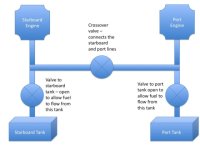Been searching the site for information on twin fuel tank configuration and have not found an answer to our concern.
We have twin tanks for our 40HP engines. They are setup so that you run both engines off one tank, then switch to the other tank as needed.
We are considering re-configuring the system so that each engine runs on its own tank. In addition, we would retain the capability for each engine to switch to the other tank.
Any thoughts about this strategy before we make the big leap?
We have twin tanks for our 40HP engines. They are setup so that you run both engines off one tank, then switch to the other tank as needed.
We are considering re-configuring the system so that each engine runs on its own tank. In addition, we would retain the capability for each engine to switch to the other tank.
Any thoughts about this strategy before we make the big leap?

